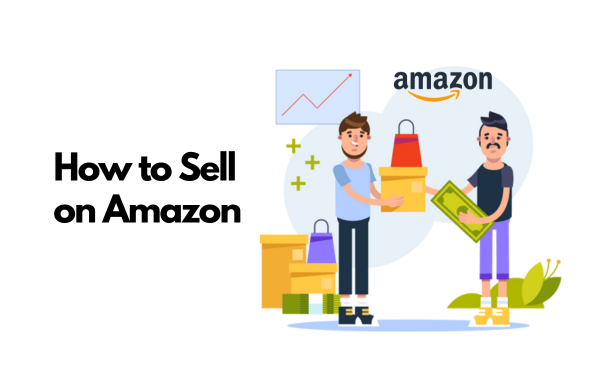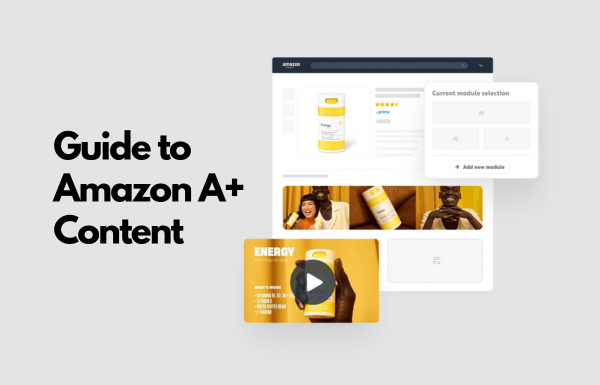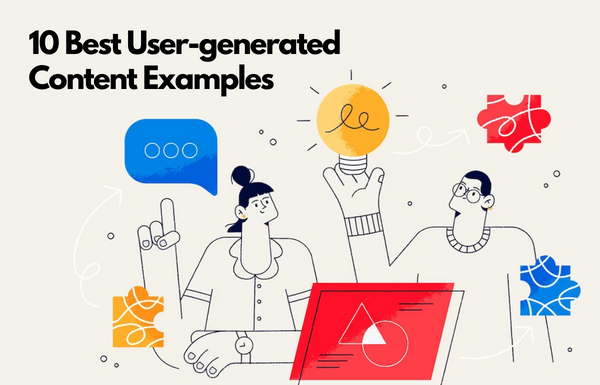You must have heard the tortoise and the rabbit story at least once in your lifetime. How the tortoise wins the race and inspires us to keep moving slowly and steadily to reach our goals in life. For this reason, your first step should be towards Shopify speed optimization, especially if you don’t wish to lose potential customers to a faster competitor store.
In this blog, we are going to shed light on the importance of Shopify speed optimization for your online store and how you can accomplish it for your e-commerce store.
- How does Shopify Store Speed Affect Your Store Performance?
- What is the good Shopify speed score?
- Best Ways to Speed Up the Shopify Store
- # Shopify speed optimization Tip 1 – Detect and Resolve the speed issue
- #Shopify speed optimization Tip 2 – Use a fast and responsive theme
- #Shopify speed optimization Tip 3 – Implement the lazy loading
- #Shopify speed optimization Tip 4 – Compress large images and videos
- #Shopify speed optimization Tip 5 – Implement AMP for lightning-fast store speed
- #Shopify speed optimization Tip 6 – Minimize redirects and fix broken links
- #Shopify speed optimization Tip 7 – Limit Third-Party JavaScript & Shopify Apps
- #Shopify speed optimization Tip 8 – Brownie Point: Focus on Optimizing Shopify Store Performance For Mobile Devices
- 9. A final checklist on Shopify speed optimization
- In Conclusion: Consulting Shopify Experts can Go a Long Way
How does Shopify Store Speed Affect Your Store Performance?
There is not one but many reasons that draw attention to the necessity of Shopify speed optimization. Some of them are described below.
Cart Abandonment
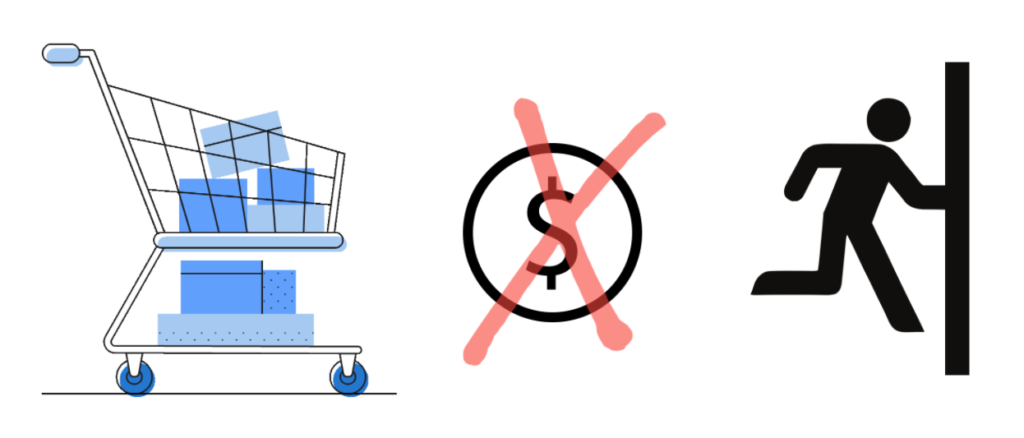
When a shopper enters your site, it means he or she has some interest in your store. If the store performance drops, so does the visitor’s expectation from your store. As a result, the shopper exits the site before the transaction.
Statistics show, that 53% of visitors from mobile devices abandon a website if it takes more than 3 seconds to load (Source: websitesetup.org [1]).
Low Recurring Purchase
Over 79% of users dissatisfied with the store performance are less likely to buy again. (Source: Shopify [2]). This statistic clearly narrates the connection between Shopify store speed and user experience.
The customer who suffered from a bad shopping experience would always go for an alternative store that offers a good shopping experience.
Reduced Sales & Revenue

Approx. 47% of all the online shoppers on the web expect the page to load in under 2 seconds (Source: Shopify [3]). If your Shopify site takes more than 2 seconds to load, it can affect the all-over user experience. Ultimately, this affects your sales, leading to a significant loss of revenue.
Hence, it makes Shopify speed optimization very important as it can be very helpful for you to impart memorable experiences to potential customers.
And now we have reached the point where we address the elephant in the room.
What is the good Shopify speed score?
Before you make efforts to speed up your online store, you must know what’s a good Shopify speed score you need to target for your website. A good Shopify speed score is above 70. However, you should always target a speed score above 90 while doing Shopify speed optimization.
Don’t know how to check the speed score of your Shopify site? Follow the steps below.
Check the speed score of your Shopify site
- Go to Google Pagespeed insights [4] or other speed test tools.
- Enter your Shopify store URL or your website URL.
- Click on the Analyse button.
In a moment, you can see the speed score for your Shopify store as below:
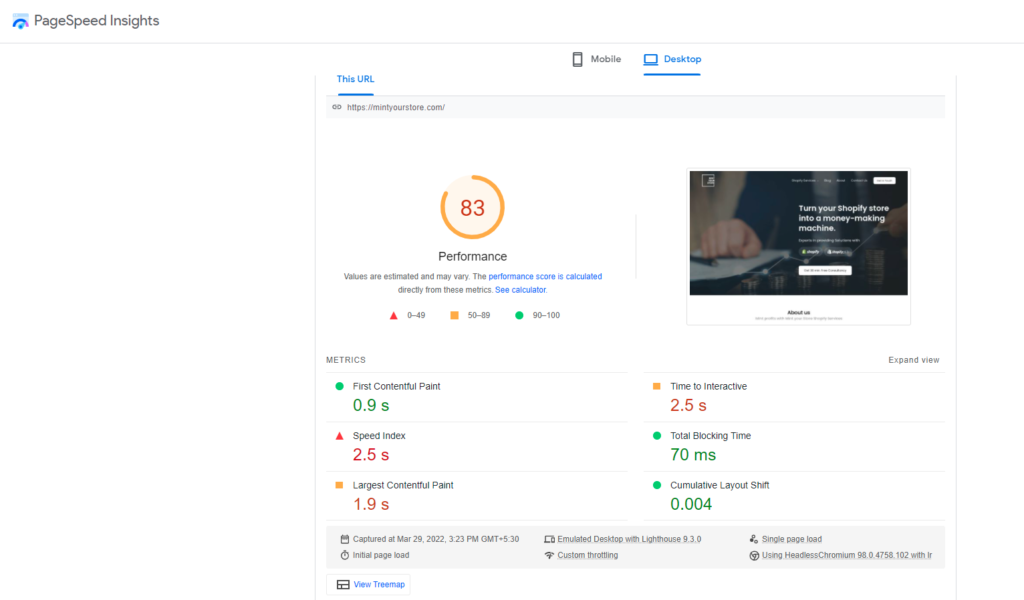
You can also check the mobile speed score for your store using the “mobile” tab.
Best Ways to Speed Up the Shopify Store
This article will cover all the ins and outs of this dilemma in detail to help you with Shopify speed optimization like a pro. Read on.
# Shopify speed optimization Tip 1 – Detect and Resolve the speed issue

It’s advisable to know where you stand before you start. So, commence by testing the current Shopify store speed. Run tests for every device – mobile, tablet, and desktop. It will help you get a brief of your store performance on all devices.
There are several tools available free of cost to get this job done in seconds. The most recommended one is the PageSpeed Insights tool [5] by Google. It gives you a bundle of information apart from the page speed score to make your website lightning fast. The information is delivered separately for desktop and mobile which includes critical elements like:
- Avoiding landing page redirects
- Minify JavaScript and CSS
- Lower server response time and others.
Another free tool that you can leverage for determining the page speed score is GTmetrix [6]. It gives you a concise report on the time taken for each request to fulfil, page performance via grades, and more.
#Shopify speed optimization Tip 2 – Use a fast and responsive theme
A theme is the face of any brand. While picking one for your Shopify store, widen your search circle from aesthetics to a performance standpoint. Here are some tips suggested by experts that will help you select the right theme to optimize Shopify store speed.
- Aesthetics: Decide on the one that matches well with your brand’s idea, value, products, and audience.
- Performance: Look out for themes that are lightweight, load quickly and come with all the required features.
- Test: Don’t forget to check the live preview of the theme of your Shopify store. Do run it on Google PageSpeed Insights tool to learn how you can make it faster.
Read More: Shopify 2.0 themes: 10 Best Free & Paid themes for your Shopify store
#Shopify speed optimization Tip 3 – Implement the lazy loading

It’s frustrating for online shoppers when the store takes time to load. A delay of a second or two may seem fine to you but feels like forever to them. It often backfires when the user abandons the website and never returns.
Well, the smartest way to deal with this problem is by implementing “lazy loading”. The concept behind lazy loading is demand and supply. In simple words, the content only loads when the user scrolls up or down to see it; be it the image, content, or videos. Else at first, only the content which is above the fold will load completely.
This way, the browser won’t be busy loading the entire website. The site will load within milliseconds thus retaining the user experience you wish to deliver to your store.
#Shopify speed optimization Tip 4 – Compress large images and videos

Images and videos are the lifeblood of any e-commerce website. However large-sized files for both categories slow down the speed of a Shopify store. They remain unoptimized and damage the overall performance of the website.
To rectify the same, you must compress them to an ideal size. Make sure the images and videos remain in high resolution even after you compress them to retain their quality. Smaller file sizes will make the browser load fast and outperform store visitors’ expectations.
Pro Tip: You can utilize tools like TinyJPG [7], TinyPNG [8], Optimizilla [9], and others to reduce the file sizes.
#Shopify speed optimization Tip 5 – Implement AMP for lightning-fast store speed
Google never left an opportunity to excel in its user experience. When it saw that mobiles are becoming a necessity over just being a luxury item, it released AMP (Accelerated Mobile Pages).
AMP was created to speed up the mobile web. In AMP, some parts of your Shopify store are converted to AMP. These are further indexed with Google, facilitating super-fast page load time and higher placements on mobile search results.
Pro Tip: AMP can only be implemented in Shopify via apps such as FireAMP [10], Shop Sheriff [11], RocketAmp [12] apps, and others.
#Shopify speed optimization Tip 6 – Minimize redirects and fix broken links

Performance problems related to SEO rankings and Shopify store speed can occur when too many redirects and broken links are present on your site. These not only worsen the user experience but also eat down potential leads. The best way you can save your store from these damaging effects is by fixing them right away.
For redirects, you can utilize the built-in redirect function in Shopify known as “URL redirect” for applying 301 redirects on your store. It will save your website’s SEO from triggering additional HTTP requests or delayed data transfers.
For broken links, start by testing your store with the help of Broken Link Checker [13], Xenu [14], and others to find and remove them.
Read More: 10 Best SEO Apps For Shopify to Boost Your Store Visibility
#Shopify speed optimization Tip 7 – Limit Third-Party JavaScript & Shopify Apps

Each Shopify store has unique demands. To fulfill them, Shopify offers apps that allow the store owners to add functionality to their website as required. These apps may come free of cost but when implemented without knowledge can cause major damage to your online store.
It happens as follows.
Whenever you add a script or an app to your Shopify store, remember that it also adds the total number of requests that your website is making. As a result of many requests to execute, the browser takes time to load the website; ultimately hurting your Shopify store speed.
So, it is recommended that you install only those third-party apps that add value to your store.
#Shopify speed optimization Tip 8 – Brownie Point: Focus on Optimizing Shopify Store Performance For Mobile Devices

Did you know the total number of mobile users in the world? It’s 5.2 billion.
In 2021, mobile e-commerce revenue was expected to reach $3.56 trillion (source: SimiCart [15]), which was 22.3% more than the previous year.
Therefore, with the increase in the number of smartphone users, it is necessary to pay attention to Shopify speed optimization for mobile devices. It will save you from losing a good bunch of potential customers to your competitors.
9. A final checklist on Shopify speed optimization
Now that you are well acquainted with the important tips to speed up a Shopify site, let me give you a small checklist that will further help you ace it all. I hope you have got your pen and paper ready. Let’s start.
- Track and optimize codes via Google tag manager
- Use static images instead of GIFs
- Avoid using sliders; instead, use a hero layout
- Minimize the number of HTTP requests
- Reduce social media buttons
- Use a content delivery network (CDN)
In Conclusion: Consulting Shopify Experts can Go a Long Way
This is everything a professional could tell you on Shopify speed optimization. So, letting an expert work on this task will help you fix many more things. Mint Your Store has the best resources to help you get Shopify speed optimization precisely.
What can they do for you?
The Shopify expert developers at Mint Your Store help you run your store hassle-free. With dedicated Shopify store optimization engineers, they will cater to your every small requirement as their top priority. Start focusing on growth and various crucial aspects of your eCommerce business that requires your utmost attention. Catch up with us to discuss everything and get started today!



